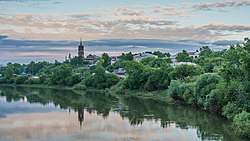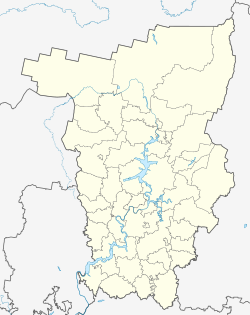Town in Perm Krai, Russia
| Kungur Кунгур | |
|---|---|
| Town | |
 Sylva River and Kungur Sylva River and Kungur | |
 Flag Flag Coat of arms Coat of arms | |
| Location of Kungur | |
  | |
| Coordinates: 57°26′N 56°56′E / 57.433°N 56.933°E / 57.433; 56.933 | |
| Country | Russia |
| Federal subject | Perm Krai |
| Founded | 1648 |
| Elevation | 120 m (390 ft) |
| Population | |
| • Total | 66,074 |
| • Rank | 236th in 2010 |
| Administrative status | |
| • Subordinated to | town of krai significance of Kungur |
| • Capital of | Kungursky District, town of krai significance of Kungur |
| Municipal status | |
| • Urban okrug | Kungur Urban Okrug |
| • Capital of | Kungur Urban Okrug, Kungursky Municipal District |
| Time zone | UTC+5 (MSK+2 |
| Postal code(s) | 617470–617480 |
| OKTMO ID | 57722000001 |
| Website | www |
Kungur (Russian: Кунгу́р) is a town in the southeast of Perm Krai, Russia, located in the Ural Mountains at the confluence of the rivers Iren and Shakva with the Sylva (Kama's basin). Population: 66,074 (2010 Census); 68,943 (2002 Census); 81,402 (1989 Soviet census); 62,173 (2023 Estimate).
History

Kungur was founded 17 kilometers (11 mi) above the Iren's mouth on the banks of the Kungurka in 1648. In 1662, it was burnt by Bashkirs. In 1663, it was rebuilt as a fortress on the place of the village of Mysovskoye. In the beginning of the 18th century, leather and footwear industries started to develop here, and in 1724, a tannery was built. By the mid-18th century, Kungur became one of the most populated areas in the Urals. In 1759, Perm administration of mining plants was moved to Kungur. By the end of the 18th century, Kungur was an important transit trade center of the Siberian road, as well as the center of leather manufacture in Perm Governorate. Kungur rope and linseed oil were widely known. In 1774, the town withstood a siege by Yemelyan Pugachev's Cossack forces. By the end of the 19th century, Kungur had become a significant industrial (including manufacture of leather footwear, gloves, and mittens) and cultural center.
In 1890 the Kungurian Age of the Permian Period of geological time was named for Kungur.
Kungur was the seat of the 1411th Artillery Ammunition Depot from 11 August 1941, the day of its establishment, to July 1945.
Coat of arms

The town's original coat of arms became official according with the Highest Law of Empress Anna Ioannovna in 1737. The current coat of arms was adopted in 1994.
Etymology
The name of the city was given by the Kungur River, which flows into the Iren at the site of the construction of the first fort. The hydronym arose under the influence of the Volga Bulgars (Ogur and Hungarian tribes) who came to the Volga-Kama territory in the 7th century, from them the name Kungur < Hungur < Vungur < Ungur is the name of the Onogur (On ogur) and Hungarian tribes. On the territory of Perm the Great and Udmurtia, archaeologists find quite a lot of Bulgar objects.
Administrative and municipal status
Within the framework of administrative divisions, Kungur serves as the administrative center of Kungursky District, even though it is not a part of it. As an administrative division, it is incorporated separately as the town of krai significance of Kungur—an administrative unit with the status equal to that of the districts. As a municipal division, the town of krai significance of Kungur is incorporated as Kungur Urban Okrug.
Economy
Major industries are SIA Turbobur and JSK "Kungur-footwear" (leather including army footwear). The town produces art goods (souvenirs from stone, maiolica), musical instrument (guitars) factories, repair-mechanical plant, clothing and knitting mills, and food industry companies. Rye, wheat, oats, barley, potatoes, vegetables are grown in Kungur, and the town also has meat-dairy cattle husbandry and aviculture.
Transportation
Kungur is located at the crossing of the Solikamsk route, the Siberian path, and the Trans-Siberian Highway.

Architecture
Among the notable buildings in Kungur are the Transfiguration Church (1781), Nikola Cathedral, former Guest courtyard with the Burse (1865–76, architect R. O. Karvovsky), the Zyryanov Hospice (1881, now the surgical department of a hospital), the 19th century storehouses of the Kopakov merchants (now a culture center).
The Tikhvinsky Temple was built in 1763 and got its name from the holy icon of Tikhvinskaya Bogomater. Now the movie theater "Oktyabr" is located in the building.
In the lower part of the town, on Kittarskaya street, is the Uspenskaya Church, built in 1761. On the opposite bank of the Sylva river stands the Preobrazhensky Temple.
Tourism and attractions
Kungur Ice Cave
Main article: Kungur Ice CaveThe Kungur Ice Cave is located in the vicinity of Kungur, on the right bank of the Sylva River. Ramified passages stretch under the ground for over 6,000 meters, and only a small part has already been explored. To this day, old slides and crumblings do not allow to determine the total length of the passages. In the explored part of the cave there are several dozens of grottoes; the largest one, which is called the Druzhba (Friendship) Grotto, was given its name in honor of the participants of the International Geological Congress who visited the cave in 1937. Inside this grotto there is a lake with the area of 750 m. The grottoes are "adorned" with columns of stalagmites and icicles of stalactites up to two meters in height. Over millennia, limestone bearing water has created an infinite variety of forms in the cave, like snowflakes which change in size during the year and reach the size of a maple leaf during late winter. The cave is filled with water from the Sylva River twice a year, in spring and in fall, when it is not accessible to tourists.
Sky Fair and Сity Day
Education
Educational facilities in the town include:
- Kungur Lyceum
- Kungur College of Woodwork
- Kungur Professional Art Lyceum
- School of Arts
- Kungur Pedagogical College
- Kungur Agricultural College
- Kungur College of Autotransport
Sister city
References
Notes
- ^ Law #416-67
- ^ Russian Federal State Statistics Service (2011). Всероссийская перепись населения 2010 года. Том 1 [2010 All-Russian Population Census, vol. 1]. Всероссийская перепись населения 2010 года (in Russian). Federal State Statistics Service.
- ^ Law #1769-367
- Law #1987-436
- "Об исчислении времени". Официальный интернет-портал правовой информации (in Russian). June 3, 2011. Retrieved January 19, 2019.
- Почта России. Информационно-вычислительный центр ОАСУ РПО. (Russian Post). Поиск объектов почтовой связи (Postal Objects Search) (in Russian)
- Federal State Statistics Service (May 21, 2004). Численность населения России, субъектов Российской Федерации в составе федеральных округов, районов, городских поселений, сельских населённых пунктов – районных центров и сельских населённых пунктов с населением 3 тысячи и более человек [Population of Russia, Its Federal Districts, Federal Subjects, Districts, Urban Localities, Rural Localities—Administrative Centers, and Rural Localities with Population of Over 3,000] (XLS). Всероссийская перепись населения 2002 года (in Russian).
- Всесоюзная перепись населения 1989 г. Численность наличного населения союзных и автономных республик, автономных областей и округов, краёв, областей, районов, городских поселений и сёл-райцентров [All Union Population Census of 1989: Present Population of Union and Autonomous Republics, Autonomous Oblasts and Okrugs, Krais, Oblasts, Districts, Urban Settlements, and Villages Serving as District Administrative Centers]. Всесоюзная перепись населения 1989 года (in Russian). Институт демографии Национального исследовательского университета: Высшая школа экономики . 1989 – via Demoscope Weekly.
- https://rosstat.gov.ru/storage/mediabank/Bul_MO_2023.xlsx
- "На российском военном складе в Приднестровье ежедневно проводится инвентаризация и проверка безопасности" (in Russian). REGNUM News Agency. December 10, 2008.
Sources
- Законодательное собрание Пермской области. Закон №416-67 от 28 февраля 1996 г. «Об административно-территориальном устройстве Пермского края», в ред. Закона №504-ПК от 9 июля 2015 г. «О внесении изменений в Закон Пермской области "Об административно-территориальном устройстве Пермского края"». Вступил в силу с момента опубликования. Опубликован: "Звезда", №38, 12 марта 1996 г. (Legislative Assembly of Perm Oblast. Law #416-67 of February 28, 1996 On the Administrative-Territorial Structure of Perm Krai, as amended by the Law #504-PK of July 9, 2015 On Amending the Law of Perm Oblast "On the Administrative-Territorial Structure of Perm Krai". Effective as of the moment of publication.).
- Законодательное собрание Пермской области. Закон №1769-367 от 10 ноября 2004 г. «Об утверждении границ и о наделении статусом муниципального образования "Город Кунгур" Пермского края», в ред. Закона №499-ПК от 16 октября 2009 г «О внесении изменений в отдельные законодательные акты Пермской области и Коми-Пермяцкого автономного округа». Вступил в силу через десять дней со дня официального опубликования. Опубликован: "Бюллетень Законодательного Собрания и администрации Пермской области", №12, I часть, 9 декабря 2004 г. (Legislative Assembly of Perm Oblast. Law #1769-367 of November 10, 2004 On Establishing the Borders and on Granting the Status to the Municipal Formation of the "Town of Kungur" of Perm Krai, as amended by the Law #499-PK of October 16, 2009 On Amending Various Legislative Acts of Perm Oblast and Komi-Permyak Autonomous Okrug. Effective as of the day which is ten days following the day of the official publication.).
- Законодательное собрание Пермской области. Закон №1987-436 от 27 декабря 2004 г. «Об утверждении границ и о наделении статусом муниципальных образований Кунгурского района Пермского края», в ред. Закона №273-ПК от 14 декабря 2013 г. «О внесении изменений в отдельные Законы Пермской области, Коми-Пермяцкого автономного округа, Пермского края». Вступил в силу через десять дней со дня официального опубликования. Опубликован: "Российская Газета", №2, 13 января 2005 г. (Legislative Assembly of Perm Oblast. Law #1987-436 of December 27, 2004 On Establishing the Borders and on Granting the Status to the Municipal Formations of Kungursky District of Perm Krai, as amended by the Law #273-PK of December 14, 2013 On Amending Various Laws of Perm Oblast, Komi-Permyak Autonomous Okrug, Perm Krai. Effective as of the day which is ten days following the day of the official publication.).
External links
- Unofficial website of Kungur
- Kungur Ice Cave
- Kungur News Archived December 5, 2020, at the Wayback Machine (in Russian)
| Administrative divisions of Perm Krai | |||
|---|---|---|---|
| Administrative center: Perm • Rural localities | |||
| Administrative districts |
| ||
| Administrative districts of Komi-Permyak Okrug | |||
| Closed administrative-territorial formations | |||
| Cities and towns (all levels) | |||
| Urban-type settlements | |||



